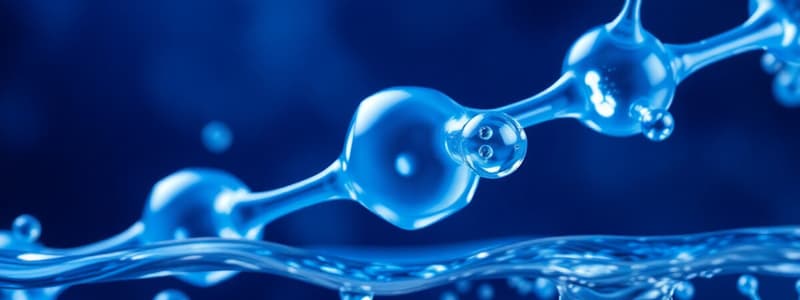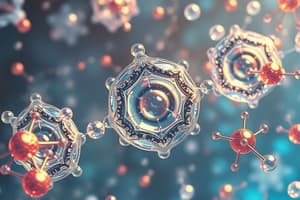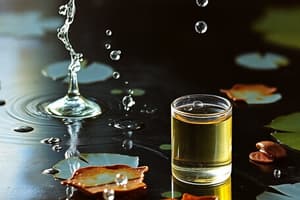Podcast
Questions and Answers
Explain how hydrogen bonds form (explanation must include polar covalent bonds)
Explain how hydrogen bonds form (explanation must include polar covalent bonds)
Hydrogen bonds form when a slightly positive hydrogen atom in one molecule is attracted to a slightly negative atom (usually oxygen or nitrogen) in another molecule. These attractions are weaker than covalent bonds, but they are crucial for many biological processes, such as holding DNA strands together and stabilizing the structure of proteins.
Define/provide examples of the following properties of water:
Define/provide examples of the following properties of water:
- Water is a universal solvent. An example is that it has the ability to dissolve a wide variety of substances (correct)
- Cohesion is the attraction between 2 of the same substances. An example would be water molecules sticking together. (correct)
- The amount of heat needed to raise the temperature of 1 gram of water by 1°C. An example is why water takes a relatively long time to boil. (correct)
- This is the attraction of water to a smaller diameter tube. An example is water moving up a plant's stem. (correct)
- Water is less dense as a solid than a liquid. An example is ice floating on water. (correct)
- Adhesion is the attraction between 2 different substances. An example would be water being attracted to the glass in a graduated cylinder. (correct)
Include an image of the following functional groups:
Include an image of the following functional groups:
There is no image provided.
Explain the difference between a dehydration and hydrolysis reactions (be able to recognize an image of each)
Explain the difference between a dehydration and hydrolysis reactions (be able to recognize an image of each)
How does saturation affect fatty acid structure/function?
How does saturation affect fatty acid structure/function?
What determines the primary structure of a protein?
What determines the primary structure of a protein?
Would the function of a protein change if the amino acid sequence changed? Why or why not?
Would the function of a protein change if the amino acid sequence changed? Why or why not?
What interactions occur in the (select all that apply):
What interactions occur in the (select all that apply):
What three components make up a nucleotide?
What three components make up a nucleotide?
List the 5 possible nitrogen bases
List the 5 possible nitrogen bases
What is the difference in how A bonds to T versus C to G?
What is the difference in how A bonds to T versus C to G?
Compare and contrast DNA and RNA. 2 comparisons and 4 contrasts
Compare and contrast DNA and RNA. 2 comparisons and 4 contrasts
Identify the main differences between prokaryotic and eukaryotic cells.
Identify the main differences between prokaryotic and eukaryotic cells.
Trace the path of a protein, from production to final product
Trace the path of a protein, from production to final product
Identify the function of the following organelles:
Identify the function of the following organelles:
Why would an organelle have a highly folded inner membrane (chloroplasts and mitochondria)
Why would an organelle have a highly folded inner membrane (chloroplasts and mitochondria)
What happens to the surface area to volume ratio as a cell grows?
What happens to the surface area to volume ratio as a cell grows?
Do you want a large or small surface area to volume ratio? Why?
Do you want a large or small surface area to volume ratio? Why?
What adaptations do cells have to increase their ratio?
What adaptations do cells have to increase their ratio?
Calculate the surface area to volume ratio of the following: a) A spherical with a radius of 5 µm b) A cuboidal cell with a side length of 7 µm
Calculate the surface area to volume ratio of the following: a) A spherical with a radius of 5 µm b) A cuboidal cell with a side length of 7 µm
Identify each letter in the image below (not H-I):
Identify each letter in the image below (not H-I):
What molecule embeds itself within the membrane and affects fluidity? How does it affect fluidity?
What molecule embeds itself within the membrane and affects fluidity? How does it affect fluidity?
What type of molecules are able to pass through the membrane and why?
What type of molecules are able to pass through the membrane and why?
Identify the molecules as polar or nonpolar:
Identify the molecules as polar or nonpolar:
What are the main differences between passive and active transport?
What are the main differences between passive and active transport?
Is facilitated diffusion a type of active or passive transport?
Is facilitated diffusion a type of active or passive transport?
What molecule is necessary for active transport?
What molecule is necessary for active transport?
Define the following and explain what would happen to a cell placed in those solutions:
Define the following and explain what would happen to a cell placed in those solutions:
If the concentration of NaCl inside a plant cell is 0.45M, which way will water diffuse if the cell is placed in a 0.25M NaCl solution?
If the concentration of NaCl inside a plant cell is 0.45M, which way will water diffuse if the cell is placed in a 0.25M NaCl solution?
The concentration of an NaCl solution is 0.5 M. This solution is in a beaker sitting on your desk in the open air. Calculate the solute potential at 22°C.
The concentration of an NaCl solution is 0.5 M. This solution is in a beaker sitting on your desk in the open air. Calculate the solute potential at 22°C.
The molar concentration of a sugar solution is 0.2M. This beaker is sitting on your desk in the open air. Calculate the water potential at 27°C.
The molar concentration of a sugar solution is 0.2M. This beaker is sitting on your desk in the open air. Calculate the water potential at 27°C.
Describe the endosymbiotic theory in your own words
Describe the endosymbiotic theory in your own words
What evidence is there that supports the endosymbiotic theory?
What evidence is there that supports the endosymbiotic theory?
Flashcards
Hydrogen bond
Hydrogen bond
A type of weak chemical bond formed between a slightly positive hydrogen atom and a slightly negative atom, often oxygen or nitrogen.
Cohesion
Cohesion
The tendency of water molecules to stick together due to hydrogen bonding.
Adhesion
Adhesion
The tendency of water molecules to stick to other surfaces due to hydrogen bonding.
Capillary action
Capillary action
Signup and view all the flashcards
Specific heat
Specific heat
Signup and view all the flashcards
Less dense as a solid
Less dense as a solid
Signup and view all the flashcards
Universal solvent
Universal solvent
Signup and view all the flashcards
Functional group
Functional group
Signup and view all the flashcards
Dehydration reaction
Dehydration reaction
Signup and view all the flashcards
Hydrolysis reaction
Hydrolysis reaction
Signup and view all the flashcards
Carbohydrate
Carbohydrate
Signup and view all the flashcards
Lipid
Lipid
Signup and view all the flashcards
Protein
Protein
Signup and view all the flashcards
Nucleic acid
Nucleic acid
Signup and view all the flashcards
Unsaturated fatty acid
Unsaturated fatty acid
Signup and view all the flashcards
Saturated fatty acid
Saturated fatty acid
Signup and view all the flashcards
Primary structure of a protein
Primary structure of a protein
Signup and view all the flashcards
Secondary structure of a protein
Secondary structure of a protein
Signup and view all the flashcards
Tertiary structure of a protein
Tertiary structure of a protein
Signup and view all the flashcards
Quaternary structure of a protein
Quaternary structure of a protein
Signup and view all the flashcards
Nucleotide
Nucleotide
Signup and view all the flashcards
Nitrogenous base
Nitrogenous base
Signup and view all the flashcards
Difference between DNA and RNA
Difference between DNA and RNA
Signup and view all the flashcards
Prokaryotic cell
Prokaryotic cell
Signup and view all the flashcards
Eukaryotic cell
Eukaryotic cell
Signup and view all the flashcards
Protein synthesis
Protein synthesis
Signup and view all the flashcards
Ribosome
Ribosome
Signup and view all the flashcards
Rough ER
Rough ER
Signup and view all the flashcards
Smooth ER
Smooth ER
Signup and view all the flashcards
Golgi apparatus
Golgi apparatus
Signup and view all the flashcards
Lysosome
Lysosome
Signup and view all the flashcards
Vacuole
Vacuole
Signup and view all the flashcards
Mitochondrion
Mitochondrion
Signup and view all the flashcards
Chloroplast
Chloroplast
Signup and view all the flashcards
Enzyme
Enzyme
Signup and view all the flashcards
Active site
Active site
Signup and view all the flashcards
Substrate
Substrate
Signup and view all the flashcards
Allosteric site
Allosteric site
Signup and view all the flashcards
Autotroph
Autotroph
Signup and view all the flashcards
Heterotroph
Heterotroph
Signup and view all the flashcards
Study Notes
Unit 1: Water and Biological Molecules
- Hydrogen bonds form between polar covalent bonds
- Water exhibits cohesion, adhesion, capillary action, high specific heat, and is less dense as a solid.
- Key functional groups include hydroxyl, carbonyl, carboxyl, amino, and phosphate.
- Dehydration reactions build polymers and hydrolysis reactions break them down.
- Macromolecules include carbohydrates, lipids, proteins, and nucleic acids
- Saturation affects fatty acid structure and function.
- Protein primary structure is determined by amino acid sequence.
- Protein function can change with alterations in amino acid sequence.
- Protein structures include secondary (interactions), tertiary, and quaternary interactions.
- Nucleotides consist of a sugar, a phosphate, and a nitrogenous base.
- DNA's bases are A, T, C, and G, with A bonding to T and C bonding to G.
- RNA is different from DNA in structure and function.
Unit 2: Cells & Cell Structure
- Prokaryotic cells differ structurally from eukaryotic cells.
- Organelles like ribosomes, rough ER, smooth ER, Golgi, lysosomes, vacuoles, mitochondria, and chloroplasts have specific functions.
- A highly folded membrane increases the surface area to volume ratio in organelles like chloroplasts and mitochondria.
- Cells regulate their surface area-to-volume ratio.
- Molecules like cholesterol affect membrane fluidity.
- Specific molecules, like polar and nonpolar molecules, pass through the membrane, based on their structures.
Unit 3: Membranes and Transport
- Passive transport diffuses molecules down a gradient; active transport moves molecules against a gradient.
- Facilitated diffusion is passive transport assisted by proteins.
- Solutions like hypertonic, isotonic, and hypotonic influence water movement in and out of cells.
- Osmosis is the movement of water across a membrane.
- Enzymes are macromolecules that belong to the protein class.
- Enzymes have an active site, substrate, and allosteric site.
- Enzymes catalyze biochemical reactions
- Temperature affects enzyme function.
- Inhibition types include competitive and non-competitive.
- Autotrophs and heterotrophs differ from each other.
- Photosynthesis takes place in two stages: light dependent, and light independent reactions.
- Chlorophyll is crucial for photosynthesis.
Unit 4: Cell Signaling
- Communication within an organism occurs through direct contact, local signaling, and long-distance signaling.
- Cell signaling has 3 main stages: reception, transduction, and response.
- Receptors can be located outside or inside the cell.
- Second messengers carry signals within the cell.
- Protein kinases and phosphatases are involved in signal transduction pathways.
- Cells respond to signals in different ways.
Unit 5: Cell Cycle and Mitosis
- Genes can be turned "on" or "off" affecting their function.
- Feedback mechanisms (positive and negative) regulate biological activities.
- Human cells have a specific number of chromosomes.
- Mitosis and meiosis each have distinctive stages.
- Cell cycle checkpoints are critical control points that ensure accurate replication and division.
- Cyclins and CDKs are key players during cell cycle.
- Somatic cells differ from gametes in chromosome number
Unit 5: Meiosis
- Key events of meiosis (unique to meiosis compared to mitosis) are described.
- Meiosis generates genetic variation through three key mechanisms.
- Asexual reproduction differs from sexual reproduction in offspring generation.
Studying That Suits You
Use AI to generate personalized quizzes and flashcards to suit your learning preferences.




